Squares And Square Roots
Exercise 5.4
1). Find the square root of each of the following numbers by Division method.
(i) 2304 (ii) 4489
(iii) 3481 (iv) 529
(v) 3249 (vi) 1369
(vii) 5776 (viii) 7921
(ix) 576 (x) 1024
(xi) 3136 (xii) 900
Solution:
(i) 2304
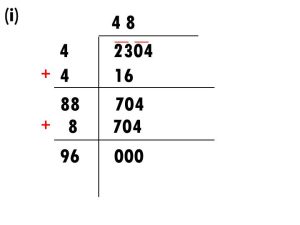
√2304 = 48
(ii) 4489
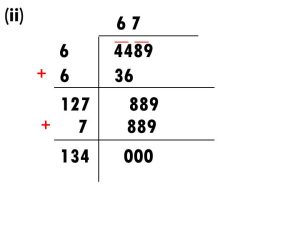
√4489 = 67
(iii) 3481

√3481 = 59
(iv) 529

√529 = 23
(v) 3249
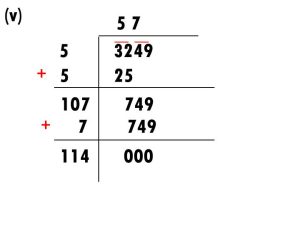
√3249 = 57
(vi) 1369
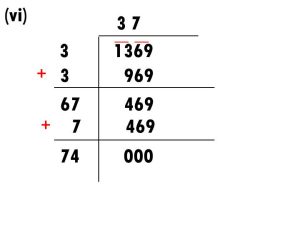
√1369 = 37
(vii) 5776

√5776 = 76
(viii) 7921

√7921 = 89
(ix) 576

√576 = 24
(x) 1024
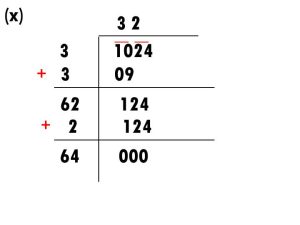
√1024 = 32
(xi) 3136

√3136 = 56
(xii) 900
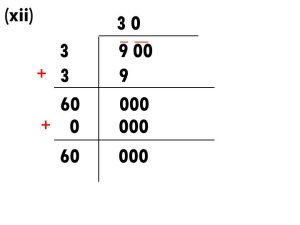
√300 = 30
2). Find the number of digits in the square root of each of the following numbers (without any calculation).
(i) 64 (ii) 144
(iii) 4489 (iv) 27225
(v) 390625
Solution:
(i) 64
Number of digits in 64 is 2
Here, n = 2 (even)
Number of digits in square root = n/2 = 2/2 = 1
(ii) 144
Number of digits in 144 is 3
Here, n = 3 (even)
Number of digits in square root = n+1/2 = 3+1/2 = 4/2 = 2
(iii) 4489
Number of digits in 4489 is 4
Here, n = 4 (even)
Number of digits in square root = n/2 = 4/2 = 2
(iv) 27225
Number of digits in 27225 is 5
Here, n = 5 (odd)
Number of digits in square root = n+1/2 = 5+1/2 = 6/2 = 3
(v) 390625
Number of digits in 390625 is 6
Here, n = 6 (even)
Number of digits in square root = n/2 = 6/2 = 3
3). Find the square root of the following decimal numbers.
(i) 2.56 (ii) 7.29
(iii) 51.84 (iv) 42.25
(v) 31.36
Solution:
(i) 2.56

√2.56 = 1.6
(ii) 7.29

√7.29 = 2.7
(iii) 51.84

√51.84 = 7.2
(iv) 42.25
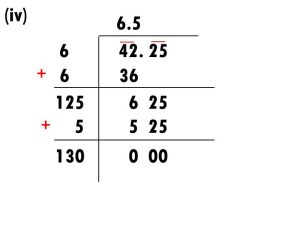
√42.25 = 6.5
(v) 31.36
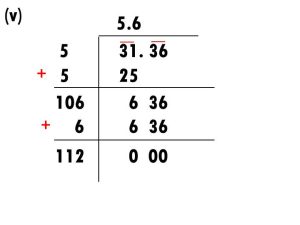
√31.36 = 5.6
4). Find the least number which must be subtracted from each of the following numbers so as to get a perfect square. Also find the square root of the perfect square so obtained.
(i) 402 (ii) 1989
(iii) 3250 (iv) 825
(v) 4000
Solution:
(i) 402

Here remainder is 2
Therefore, 2 is the least number to be subtracted
402 – 2 = 400
√400 = 20
(ii) 1989

Here remainder is 53
Therefore, 53 is the least number to be subtracted
1989 – 53 = 1936
√1936 = 44
(iii) 3250

Here remainder is 1
Therefore, 1 is the least number to be subtracted
3250 – 1 = 3249
√3249 = 57
(iv) 825

Here remainder is 41
Therefore, 41 is the least number to be subtracted
825 – 41 = 784
√784 = 28
(v) 4000

Here remainder is 31
Therefore, 31 is the least number to be subtracted
4000 – 31 = 3969
√3969 = 63
5). Find the least number which must be added to each of the following numbers so as to get a perfect square. Also find the square root of the perfect square so obtained.
(i) 525 (ii) 1750
(iii) 252 (iv) 1825
(v) 6412
Solution:
(i) 525
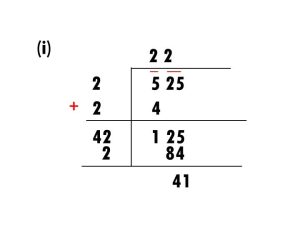
Here remainder is 41 and quotient is 22
Square of 22 is less than 525
Next number is 23
Square of 23 = 529
The least number to be added = 529 – 525 = 4
525 + 4 = 529
√529 = 23
(ii) 1750
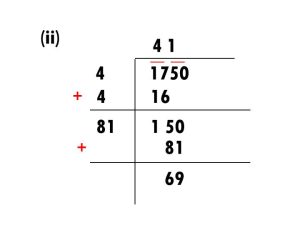
Here remainder is 69 and quotient is 41
Square of 41 is less than 1750
Next number is 42
Square of 42 = 1764
The least number to be added = 1764 – 1750 = 14
√1764 = 42
(iii) 252
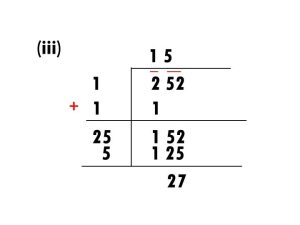
Here remainder is 27 and quotient is 15
Square of 15 is less than 252
Next number is 16
Square of 16 = 256
The least number to be added = 256 – 252 = 4
√256 = 16
(iv) 1825
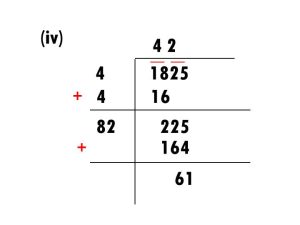
Here remainder is 61 and quotient is 42
Square of 42 is less than 1825
Next number is 43
Square of 43 = 1849
The least number to be added = 1849 – 1825 = 24
√1849 = 43
(v) 6412
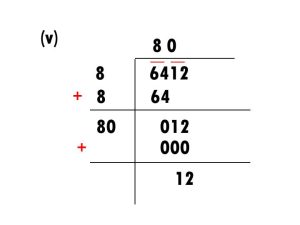
Here remainder is 12 and quotient is 80
Square of 80 is less than 6412
Next number is 81
Square of 81 =6561
The least number to be added = 6561 – 6412 = 149
√6561 = 81
6). Find the length of the side of a square whose area is 441 m2.
Given: Area of square = 441 m2
Area of square = side2
Side2 = 441
taking square root on both the sides
√side2 = √441
side = 21
Ans: Side of the square = 21m
7). In a right triangle ABC, ÐB = 90°.
(a) If AB = 6 cm, BC = 8 cm, find AC
(b) If AC = 13 cm, BC = 5 cm, find AB
Solution:
(a) If AB = 6 cm, BC = 8 cm, find AC
In ∆ABC by Pythagoras theorem
AC2 = AB2 + BC2
AC2 = 62 + 82
= 36 + 64
= 100
taking square root on both the sides
√AC2 = √100
AC = 10
(b) If AC = 13 cm, BC = 5 cm, find AB
In ∆ABC by Pythagoras theorem
AB2 + BC2 = AC2
AB2 + 52 = 132
AB2 + 25 = 169
AB2 = 169 – 25
AB2 = 144
taking square root on both the sides
√AB2 = √144
AB = 12
8). A gardener has 1000 plants. He wants to plant these in such a way that the number of rows and the number of columns remain same. Find the minimum number of plants he needs more for this.
Total plants = 1000
Number of columns = number of rows
1000 is not a perfect square.

Here remainder is 39 and quotient is 31
Square of 31 is less than 1000
Next number is 32
Square of 32 = 1024
The least number to be added = 1024 – 1000 = 24
Ans: Gardener requires 24 more plants
9). There are 500 children in a school. For a P.T. drill they have to stand in such a manner that the number of rows is equal to number of columns. How many children would be left out in this arrangement.
Total number of students = 500
Number of rows = number of columns
500 is not a perfect square
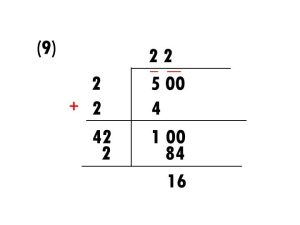
Here remainder is 16
500 – 16= 484
√484 = 22
Ans: students left out in this arrangement are 16
Click here for the solutions of Std 8 Maths
1). Rational Numbers
2). Linear Equations in One Variable
3). Understanding Quadrilaterals
4). Data Handling
5). Squares and Square Roots
![]()